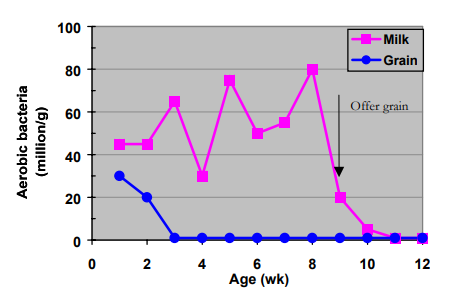Click here for a PDF version of this Calf Note
Introduction
When we wean calves, we assume that they are ready to move from a milk-based diet to one of calf starter, hay (or other forage) and water. But have you stopped to think about the changes that have to take place in the animal before its ready to move from liquid to solid? Actually, many of these changes are quite remarkable. One such changes is the concentration and composition of bacteria in the rumen.
Rumen bacteria in the preruminant animal (before rumen development begins) are quite different from those in the mature ruminant. When the calf is first born, the rumen is sterile – there are no bacteria present. However, by one day of age, a large concentration of bacteria can be found – mostly aerobic (or oxygen using) bacteria. These bacteria appear to enter the rumen from swallowing items containing bacteria from the outside environment (bedding, saliva, etc). Aerobic bacteria aren’t the type of bacteria normally found in rumens of mature animals. You can think of these bacteria as temporary – they will be replaced by bacteria that can better compete in the rumen once the calf begins to eat dry feed.

The numbers and types of bacteria change as dry feed intake occurs and the substrate available for fermentation changes. As can be seen in the figure, there is a dramatic decrease in the number of aerobic bacteria (that occurs approximately 2 weeks after calves begin to consume grain – at 1 week when calves were offered grain from birth, and at 9 weeks when calves fed only milk for 8 weeks were offered grain for the first time. The change in bacterial numbers and types is almost always a function of intake of substrate. Prior to consumption of dry feeds, bacteria in the rumen exist by fermenting ingested hair, bedding, and from milk that flows from the abomasum into the rumen. The substrate ingested will also affect the types of ruminal bacteria that flourish in the young rumen. For example, calves fed mostly hay develop a different population of bacteria from those fed mostly grain. Bacteria in the rumen contribute to the development of ruminal function and prepare the rumen for weaning. As a producer, you can stimulate the bacteria in the following ways:
- Provide fresh, clean water. Bacteria live in a water environment and a source of fresh water is important for their growth. Provide fresh water daily from birth (see Calf Note #04 – Water, water everywhere…).
- Provide fresh, clean calf starter. The rumen bacteria will ferment the carbohydrate and some of the protein in calf starter to volatile fatty acids. These acids are what drives ruminal development and cause the shift in bacterial populations. Offer starter at 3 days to promote early intake – the calves will begin eating starter, which will then drive rumen development.
- Feed calf starter for ad libitum consumption prior to weaning. When calves are limit fed calf starter, they tend to eat large amounts in a short period of time. This can have profound effects on rumen pH and influence rumen bacterial populations. So, when possible, let preweaned calves have free access to starter up to a maximum of about 7 lbs. (3.5 kg) per day.
Rumen bacteria will adapt to the changing ruminal environment quickly. Usually, within 2 weeks of introducing feed into the rumen, the bacteria in the calf’s rumen will resemble those found in adults. h, clean water is critical to successful rumen development. An important part of the calf’s development is the ability of the rumen to ferment the concentrate and forage that it eats. This is termed rumen development, and is necessary before the calf can be weaned successfully.